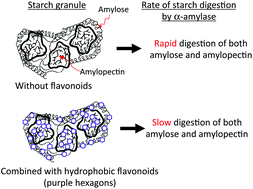当前位置:
X-MOL 学术
›
Food Funct.
›
论文详情
Our official English website, www.x-mol.net, welcomes your feedback! (Note: you will need to create a separate account there.)
Interactions of flavonoids with α-amylase and starch slowing down its digestion
Food & Function ( IF 6.1 ) Pub Date : 2017-12-05 00:00:00 , DOI: 10.1039/c7fo01539a Umeo Takahama 1, 2, 3, 4, 5 , Sachiko Hirota 1, 2, 3, 4, 5
Food & Function ( IF 6.1 ) Pub Date : 2017-12-05 00:00:00 , DOI: 10.1039/c7fo01539a Umeo Takahama 1, 2, 3, 4, 5 , Sachiko Hirota 1, 2, 3, 4, 5
Affiliation

|
Starch is digested to glucose in the intestine and absorbed into the body. If the increased blood concentrations of sugar after meals decrease slowly or are maintained for a long time, various adverse effects are induced. Therefore, it is important to decrease the rate of the digestibility of starch in the intestine in the patients of hyperglycemia. One of the ways to effect a decrease is the inhibition of α-amylase secreted from the pancreas. Flavonoids are a group of compounds that can inhibit this enzyme's activity, and many investigators have studied the flavonoid-dependent inhibition of this enzyme and presented mechanisms for the inhibition of its activity. Starch containing foods, however, cooked or ingested with flavonoid containing foods are mixed with saliva and gastric juice in the stomach. Thus, flavonoids in the foods can interact with starch and can react with nitrous acid derived from the oral cavity in the stomach before being transported to the intestine. This review mainly deals with: (i) the inhibition of α-amylase activity by flavonoids suggesting the mechanisms of the inhibition, (ii) suppression of starch digestion by flavonoids by forming starch–flavonoid complexes by hydrophobic interactions, and (iii) formation of starch not easily digested by α-amylase by the formation of covalent bonds between flavonoids and starch during cooking and in the stomach. In addition, the cooperation of flavonoids with fatty acids are discussed taking their binding to amylose into account.
中文翻译:

类黄酮与α-淀粉酶和淀粉的相互作用减慢了其消化
淀粉在肠中被消化成葡萄糖并吸收到体内。如果饭后血糖升高的血糖浓度缓慢下降或长期维持,则会引起各种不良反应。因此,重要的是降低高血糖患者肠中淀粉的消化率。减少的一种方法是抑制胰腺分泌的α-淀粉酶。黄酮类化合物是一组可以抑制这种酶活性的化合物,许多研究者已经研究了这种酶类黄酮的依赖性抑制作用,并提出了抑制其活性的机理。但是,将含淀粉的食物煮熟或与含类黄酮的食物一起摄入后,会与唾液和胃液在胃中混合。因此,食品中的类黄酮可以与淀粉相互作用,并可以与胃中源自口腔的亚硝酸反应,然后再运输到肠道。这篇综述主要涉及:(i)类黄酮对α-淀粉酶活性的抑制,表明了其抑制机理;(ii)通过疏水相互作用形成淀粉-类黄酮复合物,抑制类黄酮对淀粉的消化,以及(iii)形成在烹饪过程中和在胃中,类黄酮和淀粉之间会形成共价键,因此淀粉不易被α-淀粉酶消化。另外,讨论了类黄酮与脂肪酸的协同作用,并考虑了它们与直链淀粉的结合。这篇综述主要涉及:(i)类黄酮对α-淀粉酶活性的抑制,表明了其抑制机理;(ii)通过疏水相互作用形成淀粉-类黄酮复合物,抑制类黄酮对淀粉的消化,以及(iii)形成在烹饪过程中和在胃中,类黄酮和淀粉之间会形成共价键,因此淀粉不易被α-淀粉酶消化。另外,讨论了类黄酮与脂肪酸的协同作用,并考虑了它们与直链淀粉的结合。这篇综述主要涉及:(i)类黄酮对α-淀粉酶活性的抑制,表明了其抑制机理;(ii)通过疏水相互作用形成淀粉-类黄酮复合物,抑制类黄酮对淀粉的消化,以及(iii)形成在烹饪过程中和在胃中,类黄酮和淀粉之间会形成共价键,因此淀粉不易被α-淀粉酶消化。另外,讨论了类黄酮与脂肪酸的协同作用,并考虑了它们与直链淀粉的结合。(iii)在烹饪过程中和在胃中通过在类黄酮和淀粉之间形成共价键形成不容易被α-淀粉酶消化的淀粉。另外,讨论了类黄酮与脂肪酸的协同作用,并考虑了它们与直链淀粉的结合。(iii)在烹饪过程中和在胃中通过在类黄酮和淀粉之间形成共价键形成不容易被α-淀粉酶消化的淀粉。另外,讨论了类黄酮与脂肪酸的协同作用,并考虑了它们与直链淀粉的结合。
更新日期:2017-12-05
中文翻译:

类黄酮与α-淀粉酶和淀粉的相互作用减慢了其消化
淀粉在肠中被消化成葡萄糖并吸收到体内。如果饭后血糖升高的血糖浓度缓慢下降或长期维持,则会引起各种不良反应。因此,重要的是降低高血糖患者肠中淀粉的消化率。减少的一种方法是抑制胰腺分泌的α-淀粉酶。黄酮类化合物是一组可以抑制这种酶活性的化合物,许多研究者已经研究了这种酶类黄酮的依赖性抑制作用,并提出了抑制其活性的机理。但是,将含淀粉的食物煮熟或与含类黄酮的食物一起摄入后,会与唾液和胃液在胃中混合。因此,食品中的类黄酮可以与淀粉相互作用,并可以与胃中源自口腔的亚硝酸反应,然后再运输到肠道。这篇综述主要涉及:(i)类黄酮对α-淀粉酶活性的抑制,表明了其抑制机理;(ii)通过疏水相互作用形成淀粉-类黄酮复合物,抑制类黄酮对淀粉的消化,以及(iii)形成在烹饪过程中和在胃中,类黄酮和淀粉之间会形成共价键,因此淀粉不易被α-淀粉酶消化。另外,讨论了类黄酮与脂肪酸的协同作用,并考虑了它们与直链淀粉的结合。这篇综述主要涉及:(i)类黄酮对α-淀粉酶活性的抑制,表明了其抑制机理;(ii)通过疏水相互作用形成淀粉-类黄酮复合物,抑制类黄酮对淀粉的消化,以及(iii)形成在烹饪过程中和在胃中,类黄酮和淀粉之间会形成共价键,因此淀粉不易被α-淀粉酶消化。另外,讨论了类黄酮与脂肪酸的协同作用,并考虑了它们与直链淀粉的结合。这篇综述主要涉及:(i)类黄酮对α-淀粉酶活性的抑制,表明了其抑制机理;(ii)通过疏水相互作用形成淀粉-类黄酮复合物,抑制类黄酮对淀粉的消化,以及(iii)形成在烹饪过程中和在胃中,类黄酮和淀粉之间会形成共价键,因此淀粉不易被α-淀粉酶消化。另外,讨论了类黄酮与脂肪酸的协同作用,并考虑了它们与直链淀粉的结合。(iii)在烹饪过程中和在胃中通过在类黄酮和淀粉之间形成共价键形成不容易被α-淀粉酶消化的淀粉。另外,讨论了类黄酮与脂肪酸的协同作用,并考虑了它们与直链淀粉的结合。(iii)在烹饪过程中和在胃中通过在类黄酮和淀粉之间形成共价键形成不容易被α-淀粉酶消化的淀粉。另外,讨论了类黄酮与脂肪酸的协同作用,并考虑了它们与直链淀粉的结合。


























 京公网安备 11010802027423号
京公网安备 11010802027423号